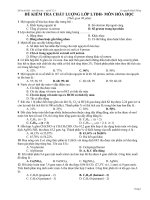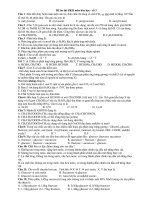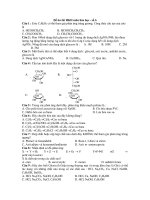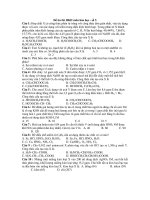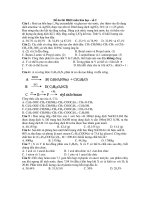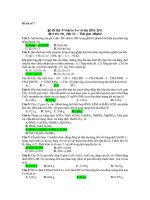Đề ôn thi thử môn hóa (722)
Bạn đang xem bản rút gọn của tài liệu. Xem và tải ngay bản đầy đủ của tài liệu tại đây (126.43 KB, 5 trang )
e1
References
1. Girotra S, et al. Survival trends in pediatric in-hospital cardiac arrests: an analysis from get with the guidelines-resuscitation. Circ
Cardiovasc Qual Outcomes. 2013;6(1):42-49.
2. Gluckman PD, et al. Selective head cooling with mild systemic hypothermia after neonatal encephalopathy: multicentre randomised
trial. Lancet. 2005;365(9460):663-670.
3. Shankaran S, et al. Whole-body hypothermia for neonates with hypoxicischemic encephalopathy. N Engl J Med. 2005;353(15):1574-1584.
4. Cam BV, et al. Randomized comparison of oxygen mask treatment
vs. nasal continuous positive airway pressure in dengue shock
syndrome with acute respiratory failure. J Trop Pediatr. 2002;48(6):
335-339.
5. Bernard SA, et al. Treatment of comatose survivors of out-of-hospital
cardiac arrest with induced hypothermia. N Engl J Med.
2002;346(8):557-563.
6. Hypothermia after Cardiac Arrest Study Group, Mild therapeutic
hypothermia to improve the neurologic outcome after cardiac arrest.
N Engl J Med. 2002;346(8):549-556.
7. Nielsen N, et al. Targeted temperature management at 33 degrees C
versus 36 degrees C after cardiac arrest. N Engl J Med. 2013;
369(23):2197-2206.
8. Moler FW, et al. Therapeutic hypothermia after out-of-hospital cardiac arrest in children. N Engl J Med. 2015;372(20):1898-1908.
9. Shankaran S, et al. Effect of depth and duration of cooling on deaths
in the NICU among neonates with hypoxic ischemic encephalopathy: a randomized clinical trial. JAMA. 2014;312(24):2629-2639.
10. Moler FW, et al. Therapeutic hypothermia after in-hospital cardiac
arrest in children. N Engl J Med. 2017;376(4):318-329.
11. Lautz AJ, et al. Hemodynamic-directed cardiopulmonary resuscitation improves neurologic outcomes and mitochondrial function in
the heart and brain. Crit Care Med. 2019;47(3):e241-e249.
12. Manole MD, et al. Brain tissue oxygen monitoring identifies cortical
hypoxia and thalamic hyperoxia after experimental cardiac arrest in
rats. Pediatr Res. 2014;75(2):295-301.
13. Kurtz P, et al. Reduced brain/serum glucose ratios predict cerebral
metabolic distress and mortality after severe brain injury. Neurocrit
Care. 2013;19(3):311-319.
14. Safar P. Cerebral resuscitation after cardiac arrest: a review. Circulation. 1986;74(6 Pt 2):Iv138-Iv153.
15. Young KD, et al. A prospective, population-based study of the
epidemiology and outcome of out-of-hospital pediatric cardiopulmonary arrest. Pediatrics. 2004;114(1):157-164.
16. Donoghue AJ, et al. Out-of-hospital pediatric cardiac arrest: an epidemiologic review and assessment of current knowledge. Ann Emerg
Med. 2005;46(6):512-522.
17. Tibballs J, Kinney S. A prospective study of outcome of in-patient
paediatric cardiopulmonary arrest. Resuscitation. 2006;71(3):310-318.
18. Moler FW, et al. In-hospital versus out-of-hospital pediatric cardiac
arrest: a multicenter cohort study. Crit Care Med. 2009;37(7):22592267.
19. Fink EL, et al. A tertiary care center’s experience with therapeutic
hypothermia after pediatric cardiac arrest. Pediatr Crit Care Med.
2010;11(1):66-74.
20. O’Rourke PP. Outcome of children who are apneic and pulseless in
the emergency room. Crit Care Med. 1986;14(5):466-468.
21. Young KD, Seidel JS. Pediatric cardiopulmonary resuscitation: a collective review. Ann Emerg Med. 1999;33(2):195-205.
22. Reis AG, et al. A prospective investigation into the epidemiology of
in-hospital pediatric cardiopulmonary resuscitation using the international Utstein reporting style. Pediatrics. 2002;109(2):200-209.
23. Li D, et al. Asphyxia-activated corticocardiac signaling accelerates
onset of cardiac arrest. Proc Natl Acad Sci U S A. 2015;112(16):E2073E2082.
24. Nadkarni VM, et al. First documented rhythm and clinical outcome
from in-hospital cardiac arrest among children and adults. JAMA.
2006;295(1):50-57.
25. Atkins DL, et al. Epidemiology and outcomes from out-of-hospital
cardiac arrest in children: the Resuscitation Outcomes Consortium
Epistry-Cardiac Arrest. Circulation. 2009;119(11):1484-1491.
26. Goldberg MP, Monyer H, Choi DW. Hypoxic neuronal injury in
vitro depends on extracellular glutamine. Neurosci Lett. 1988;94(1-2):
52-57.
27. Bodsch W, et al. Recovery of monkey brain after prolonged ischemia. II. Protein synthesis and morphological alterations. J Cereb
Blood Flow Metab. 1986;6(1):22-33.
28. Vaagenes P, et al. Asphyxiation versus ventricular fibrillation cardiac
arrest in dogs. Differences in cerebral resuscitation effects—a preliminary study. Resuscitation. 1997;35(1):41-52.
29. Cady EB. Magnetic resonance spectroscopy in neonatal hypoxicischaemic insults. Childs Nerv Syst. 2001;17(3):145-149.
30. Siesjo BK, Wieloch T. Cerebral metabolism in ischaemia: neurochemical basis for therapy. Br J Anaesth. 1985;57(1):47-62.
31. Siesjo BK, et al. Influence of acidosis on lipid peroxidation in brain
tissues in vitro. J Cereb Blood Flow Metab. 1985;5(2):253-258.
32. Hillered L, Smith ML, Siesjo BK. Lactic acidosis and recovery of
mitochondrial function following forebrain ischemia in the rat. J
Cereb Blood Flow Metab. 1985;5(2):259-266.
33. Liou AK, et al. To die or not to die for neurons in ischemia, traumatic
brain injury and epilepsy: a review on the stress-activated signaling
pathways and apoptotic pathways. Prog Neurobiol. 2003;69(2):103-142.
34. Choi DW. Ischemia-induced neuronal apoptosis. Curr Opin Neurobiol. 1996;6(5):667-672.
35. Portera-Cailliau C, Price DL, Martin LJ. Non-NMDA and NMDA
receptor-mediated excitotoxic neuronal deaths in adult brain are
morphologically distinct: further evidence for an apoptosis-necrosis
continuum. J Comp Neurol. 1997;378(1):88-104.
36. Lorek A, et al. Delayed (“secondary”) cerebral energy failure after
acute hypoxia-ischemia in the newborn piglet: continuous 48-hour
studies by phosphorus magnetic resonance spectroscopy. Pediatr Res.
1994;36(6):99-706.
37. Penrice J, et al. Proton magnetic resonance spectroscopy of the brain
during acute hypoxia-ischemia and delayed cerebral energy failure in
the newborn piglet. Pediatr Res. 1997;41(6):795-802.
38. Bralet J, Schreiber L, Bouvier C. Effect of acidosis and anoxia on
iron delocalization from brain homogenates. Biochem Pharmacol.
1992;43(5):979-983.
39. du Plessis AJ, Volpe JJ. Perinatal brain injury in the preterm and
term newborn. Curr Opin Neurol. 2002;15(2):151-157.
40. Siesjo BK, Bengtsson F. Calcium fluxes, calcium antagonists, and
calcium-related pathology in brain ischemia, hypoglycemia, and
spreading depression: a unifying hypothesis. J Cereb Blood Flow
Metab. 1989;9(2):127-140.
41. Katz LM, et al. Electron spin resonance measure of brain antioxidant
activity during ischemia/reperfusion. Neuroreport. 1998;9(7):1587-1593.
42. Andreyev A, et al. Calcium uptake and cytochrome c release from
normal and ischemic brain mitochondria. Neurochem Int.
2018;117:15-22.
43. Martin LJ, et al. Neurodegeneration in excitotoxicity, global cerebral
ischemia, and target deprivation: A perspective on the contributions
of apoptosis and necrosis. Brain Res Bull. 1998;46(4):281-309.
44. Choi DW. Ionic dependence of glutamate neurotoxicity. J Neurosci.
1987;7(2):369-379.
45. Newell DW, Malouf AT, Franck JE. Glutamate-mediated selective
vulnerability to ischemia is present in organotypic cultures of hippocampus. Neurosci Lett. 1990;116(3):325-330.
46. Kuroiwa T, et al. Regional differences in the rate of energy impairment after threshold level ischemia for induction of cerebral infarction in gerbils. Acta Neuropathol. 2000;100(6):587-594.
47. Sims NR, Pulsinelli WA. Altered mitochondrial respiration in selectively vulnerable brain subregions following transient forebrain
ischemia in the rat. J Neurochem. 1987;49(5):1367-1374.
48. Sims NR. Selective impairment of respiration in mitochondria isolated from brain subregions following transient forebrain ischemia in
the rat. J Neurochem. 1991;56(6):1836-1844.
e2
49. Zaidan E, Sims NR. Selective reductions in the activity of the pyruvate dehydrogenase complex in mitochondria isolated from brain
subregions following forebrain ischemia in rats. J Cereb Blood Flow
Metab. 1993;13(1):98-104.
50. Brierley JB, Meldrum BS, Brown AW. The threshold and neuropathology of cerebral “anoxic-ischemic” cell change. Arch Neurol.
1973;29(6):367-374.
51. Adamczak SE, et al. Pyroptotic neuronal cell death mediated by
the AIM2 inflammasome. J Cereb Blood Flow Metab. 2014;34(4):
621-629.
52. Henke N, et al. The plasma membrane channel ORAI1 mediates
detrimental calcium influx caused by endogenous oxidative stress.
Cell Death Dis. 2013;4:e470.
53. Liu K, et al. CHOP mediates ASPP2-induced autophagic apoptosis
in hepatoma cells by releasing Beclin-1 from Bcl-2 and inducing
nuclear translocation of Bcl-2. Cell Death Dis. 2014;5:e1323.
54. Au AK, et al. Evaluation of autophagy using mouse models of brain
injury. Biochim Biophys Acta. 2010;1802(10):918-923.
55. Neumar RW, et al. Post-cardiac arrest syndrome: epidemiology,
pathophysiology, treatment, and prognostication. Circulation. 2008;
118(23):2452-2483.
56. Bellamy R, et al. Suspended animation for delayed resuscitation. Crit
Care Med. 1996;24(suppl 2):S24-S47.
57. Buja LM, Eigenbrodt ML, Eigenbrodt EH. Apoptosis and necrosis.
Basic types and mechanisms of cell death. Arch Pathol Lab Med.
1993;117(12):1208-1214.
58. Vanden Berghe T, et al. Regulated necrosis: the expanding network
of non-apoptotic cell death pathways. Nat Rev Mol Cell Biol.
2014;15(2):135-147.
59. Degterev A, et al. Chemical inhibitor of nonapoptotic cell death
with therapeutic potential for ischemic brain injury. Nat Chem Biol.
2005;1(2):112-119.
60. Kerr JF, Wyllie AH, Currie AR. Apoptosis: a basic biological phenomenon with wide-ranging implications in tissue kinetics. Br J
Cancer. 1972;26(4):239-257.
61. Cao G, et al. Caspase-activated DNase/DNA fragmentation factor 40
mediates apoptotic DNA fragmentation in transient cerebral ischemia
and in neuronal cultures. J Neurosci. 2001;21(13):4678-4690.
62. Zhu C, et al. Involvement of apoptosis-inducing factor in neuronal
death after hypoxia-ischemia in the neonatal rat brain. J Neurochem.
2003;86(2):306-317.
63. Cao G, et al. Translocation of apoptosis-inducing factor in vulnerable neurons after transient cerebral ischemia and in neuronal cultures
after oxygen-glucose deprivation. J Cereb Blood Flow Metab.
2003;23(10):1137-1150.
64. Nitatori T, et al. Delayed neuronal death in the CA1 pyramidal cell
layer of the gerbil hippocampus following transient ischemia is
apoptosis. J Neurosci. 1995;15(2):1001-1011.
65. Northington FJ, et al. Delayed neurodegeneration in neonatal rat
thalamus after hypoxia-ischemia is apoptosis. J Neurosci. 2001;21(6):
1931-1938.
66. Shoykhet M, et al. Thalamocortical dysfunction and thalamic injury
after asphyxial cardiac arrest in developing rats. J Neurosci. 2012;
32(14):4972-4981.
67. Li Y, et al. Temporal profile of in situ DNA fragmentation after
transient middle cerebral artery occlusion in the rat. J Cereb Blood
Flow Metab. 1995;15(3):389-397.
68. Renolleau S, et al. Specific caspase inhibitor Q-VD-OPh prevents
neonatal stroke in P7 rat: a role for gender. J Neurochem. 2007;
100(4):1062-1071.
69. Du L, et al. Innate gender-based proclivity in response to cytotoxicity and programmed cell death pathway. J Biol Chem. 2004;
279(37):38563-38570.
70. Topjian AA, et al. Pediatric Post-Cardiac Arrest Care: A scientific
statement from the American Heart Association. Circulation.
2019;140(6):e194-e233.
71. Shintani T, Klionsky DJ. Autophagy in health and disease: a doubleedged sword. Science. 2004;306(5698):990-995.
72. Koike M, et al. Inhibition of autophagy prevents hippocampal pyramidal neuron death after hypoxic-ischemic injury. Am J Pathol.
2008;172(2):454-469.
73. Puyal J, et al. Postischemic treatment of neonatal cerebral ischemia
should target autophagy. Ann Neurol. 2009;66(3):378-389.
74. Du L, et al. Starving neurons show sex difference in autophagy. J Biol
Chem. 2009;284(4):2383-2396.
75. Wen YD, et al. Neuronal injury in rat model of permanent focal
cerebral ischemia is associated with activation of autophagic and lysosomal pathways. Autophagy. 2008;4(6):762-769.
76. Carloni S, Buonocore G, Balduini W. Protective role of autophagy
in neonatal hypoxia-ischemia induced brain injury. Neurobiol Dis.
2008;32(3):329-339.
77. Zhu C, et al. The influence of age on apoptotic and other mechanisms of cell death after cerebral hypoxia-ischemia. Cell Death Differ.
2005;12(2):162-176.
78. Au AK, et al. Ischemia-induced autophagy contributes to neurodegeneration in cerebellar Purkinje cells in the developing rat brain and
in primary cortical neurons in vitro. Biochim Biophys Acta.
2015;1852(9):1902-1911.
79. MacManus JP, Buchan AM. Apoptosis after experimental stroke:
fact or fashion? J Neurotrauma. 2000;17(10):899-914.
80. Deshpande J, et al. Ultrastructural changes in the hippocampal CA1
region following transient cerebral ischemia: evidence against programmed cell death. Exp Brain Res. 1992;88(1):91-105.
81. Lemaire C, et al. Inhibition of caspase activity induces a switch from
apoptosis to necrosis. FEBS Lett. 1998;425(2):266-270.
82. Maiuri MC, et al. Self-eating and self-killing: crosstalk between autophagy and apoptosis. Nat Rev Mol Cell Biol. 2007;8(9):741-752.
83. Portera-Cailliau C, Price DL, Martin LJ. Excitotoxic neuronal death
in the immature brain is an apoptosis-necrosis morphological continuum. J Comp Neurol. 1997;378(1):70-87.
84. Northington FJ, et al. Failure to complete apoptosis following neonatal hypoxia-ischemia manifests as “continuum” phenotype of cell
death and occurs with multiple manifestations of mitochondrial dysfunction in rodent forebrain. Neuroscience. 2007;149(4):822-833.
85. Ginet V, et al. Enhancement of autophagic flux after neonatal cerebral hypoxia-ischemia and its region-specific relationship to apoptotic mechanisms. Am J Pathol. 2009;175(5):1962-1974.
86. Northington FJ, et al. Early Neurodegeneration after hypoxia-ischemia in neonatal rat is necrosis while delayed neuronal death is
apoptosis. Neurobiol Dis. 2001;8(2):207-219.
87. Kloner RA, Przyklenk K, Whittaker P. Deleterious effects of oxygen
radicals in ischemia/reperfusion. Resolved and unresolved issues.
Circulation. 1989;80(5):1115-1127.
88. Siesjo BK, Agardh CD, Bengtsson F. Free radicals and brain damage.
Cerebrovasc Brain Metab Rev. 1989;1(3):165-211.
89. Opie LH. Reperfusion injury and its pharmacologic modification.
Circulation. 1989;80(4):1049-1062.
90. Trummer G, et al. Successful resuscitation after prolonged periods of
cardiac arrest: a new field in cardiac surgery. J Thorac Cardiovasc Surg.
2010;139(5):1325-1332, 1332.e1-2.
91. Manole MD, et al. Polynitroxyl albumin and albumin therapy after
pediatric asphyxial cardiac arrest: effects on cerebral blood flow and
neurologic outcome. J Cereb Blood Flow Metab. 2012;32(3):560-569.
92. Drabek T, et al. Global and regional differences in cerebral blood
flow after asphyxial versus ventricular fibrillation cardiac arrest in
rats using ASL-MRI. Resuscitation. 2014;85(7):964-971.
93. Hallenbeck JM. Prevention of postischemic impairment of microvascular perfusion. Neurology. 1977;27(1):3-10.
94. Rothman S. Synaptic release of excitatory amino acid neurotransmitter mediates anoxic neuronal death. J Neurosci. 1984;4(7):18841891.
95. Dugan LL, Choi DW. Excitotoxicity, free radicals, and cell membrane changes. Ann Neurol. 1994;35(suppl):S17-21.
96. Lipton SA, Rosenberg PA. Excitatory amino acids as a final common
pathway for neurologic disorders. N Engl J Med. 1994;330(9):
613-622.
e3
97. Stys PK, Waxman SG, Ransom BR. Ionic mechanisms of anoxic
injury in mammalian CNS white matter: role of Na1 channels and
Na(1)-Ca21 exchanger. J Neurosci. 1992;12(2):430-439.
98. Vest RS, et al. Effective post-insult neuroprotection by a novel
Ca(21)/ calmodulin-dependent protein kinase II (CaMKII) inhibitor. J Biol Chem. 2010;285(27):20675-20682.
99. Zhang C, et al. Comparison of calpain and caspase activities in the
adult rat brain after transient forebrain ischemia. Neurobiol Dis.
2002;10(3):289-305.
100. Bevers MB, Neumar RW. Mechanistic role of calpains in postischemic
neurodegeneration. J Cereb Blood Flow Metab. 2008;28(4):655-673.
101. Bano D, et al. Cleavage of the plasma membrane Na1/Ca21 exchanger in excitotoxicity. Cell. 2005;120(2):275-285.
102. Gill R, et al. Role of caspase-3 activation in cerebral ischemia-induced neurodegeneration in adult and neonatal brain. J Cereb
Blood Flow Metab. 2002;22(4):420-430.
103. Shimohama S, Tanino H, Fujimoto S. Differential expression of rat
brain caspase family proteins during development and aging. Biochem Biophys Res Commun. 2001;289(5):1063-1066.
104. Zhu C, et al. Different apoptotic mechanisms are activated in male
and female brains after neonatal hypoxia-ischaemia. J Neurochem.
2006;96(4):1016-1027.
105. Basu S, et al. Evidence for time-dependent maximum increase of
free radical damage and eicosanoid formation in the brain as related
to duration of cardiac arrest and cardio-pulmonary resuscitation.
Free Radic Res. 2003;37(3):251-256.
106. Kunimatsu T, et al. Cerebral reactive oxygen species assessed by
electron spin resonance spectroscopy in the initial stage of ischemia-reperfusion are not associated with hypothermic neuroprotection. J Clin Neurosci. 2011;18(4):545-548.
107. Nelson CW, et al. Oxygen radicals in cerebral ischemia. Am J
Physiol. 1992;263(5 Pt 2):H1356-H1362.
108. Ambrus A, Tretter L, Adam-Vizi V. Inhibition of the alpha-ketoglutarate dehydrogenase-mediated reactive oxygen species generation by lipoic acid. J Neurochem. 2009;109(suppl 1):222-229.
109. Dezfulian C, et al. Mechanistic characterization of nitrite-mediated
neuroprotection after experimental cardiac arrest. J Neurochem.
2016;139(3):419-431.
110. Chouchani ET, et al. Ischaemic accumulation of succinate controls
reperfusion injury through mitochondrial ROS. Nature.
2014;515(7527):431-435.
111. Bayir H, et al. Selective early cardiolipin peroxidation after traumatic brain injury: an oxidative lipidomics analysis. Ann Neurol.
2007;62(2):154-169.
112. Ji J, et al. Deciphering of mitochondrial cardiolipin oxidative signaling in cerebral ischemia-reperfusion. J Cereb Blood Flow Metab.
2015;35(2):319-328.
113. Kahles T, Brandes RP. Which NADPH oxidase isoform is relevant
for ischemic stroke? The case for nox 2. Antioxid Redox Signal.
2013;18(12):1400-1417.
114. Kontos HA. Oxygen radicals from arachidonate metabolism in abnormal vascular responses. Am Rev Respir Dis. 1987;136(2):474-477.
115. Abramov AY, Scorziello A, Duchen MR. Three distinct mechanisms generate oxygen free radicals in neurons and contribute to
cell death during anoxia and reoxygenation. J Neurosci.
2007;27(5):1129-1138.
116. Kovac S, et al. Seizure activity results in calcium- and mitochondria-independent ROS production via NADPH and xanthine oxidase activation. Cell Death Dis. 2014;5:e1442.
117. Betz AL, Randall J, Martz D. Xanthine oxidase is not a major
source of free radicals in focal cerebral ischemia. Am J Physiol.
1991;260(2 Pt 2):H563-H568.
118. Lindsay S, et al. Role of xanthine dehydrogenase and oxidase in
focal cerebral ischemic injury to rat. Am J Physiol. 1991;261(6 Pt 2):
H2051-H2057.
119. Krause GS, et al. Cardiac arrest and resuscitation: brain iron
delocalization during reperfusion. Ann Emerg Med. 1985;14(11):
1037-1043.
120. Komara JS, et al. Brain iron delocalization and lipid peroxidation
following cardiac arrest. Ann Emerg Med. 1986;15(4):384-389.
121. Garthwaite J, et al. NMDA receptor activation induces nitric oxide
synthesis from arginine in rat brain slices. Eur J Pharmacol.
1989;172(4-5):413-416.
122. Beckman JS, et al. Apparent hydroxyl radical production by peroxynitrite: implications for endothelial injury from nitric oxide and
superoxide. Proc Natl Acad Sci U S A. 1990;87(4):1620-1624.
123. Bayir H, et al. Enhanced oxidative stress in iNOS-deficient mice
after traumatic brain injury: support for a neuroprotective role of
iNOS. J Cereb Blood Flow Metab. 2005;25(6):673-684.
124. Dezfulian C, et al. Nitrite therapy after cardiac arrest reduces reactive oxygen species generation, improves cardiac and neurological
function, and enhances survival via reversible inhibition of mitochondrial complex I. Circulation. 2009;120(10):897-905.
125. de Lima Portella R, Lynn Bickta J, and Shiva S. Nitrite confers
preconditioning and cytoprotection after ischemia/reperfusion injury through the modulation of mitochondrial function. Antioxid
Redox Signal. 2015;23(4):307-327.
126. Dezfulian C, et al. Nitrite therapy is neuroprotective and safe in
cardiac arrest survivors. Nitric Oxide. 2012;26(4):241-250.
127. Lafon-Cazal M, et al. NMDA-dependent superoxide production
and neurotoxicity. Nature. 1993;364(6437):535-537.
128. Gilman SC, Bonner MJ, Pellmar TC. Free radicals enhance basal
release of D-[3H]aspartate from cerebral cortical synaptosomes. J
Neurochem. 1994;62(5):1757-1763.
129. Krause GS, et al. Assessment of free radical-induced damage in
brain proteins after ischemia and reperfusion. Resuscitation.
1992;23(1):59-69.
130. Bromont C, Marie C, Bralet J. Increased lipid peroxidation in
vulnerable brain regions after transient forebrain ischemia in rats.
Stroke. 1989;20(7):918-924.
131. Oliver CN, et al. Oxidative damage to brain proteins, loss of glutamine synthetase activity, and production of free radicals during
ischemia/reperfusion-induced injury to gerbil brain. Proc Natl Acad
Sci U S A. 1990;87(13):5144-5147.
132. Martin E, Rosenthal RE, Fiskum G. Pyruvate dehydrogenase complex: metabolic link to ischemic brain injury and target of oxidative
stress. J Neurosci Res. 2005;79(1-2):240-247.
133. Wang R, et al. Genistein attenuates ischemic oxidative damage and
behavioral deficits via eNOS/Nrf2/HO-1 signaling. Hippocampus.
2013;23(7):634-647.
134. Sobocanec S, et al. Sex-dependent antioxidant enzyme activities
and lipid peroxidation in ageing mouse brain. Free Radic Res.
2003;37(7):743-748.
135. Bazan NG. Synaptic signaling by lipids in the life and death of
neurons. Mol Neurobiol. 2005;31(1-3):219-230.
136. Shiu GK, Nemmer JP, Nemoto EM. Reassessment of brain free
fatty acid liberation during global ischemia and its attenuation by
barbiturate anesthesia. J Neurochem. 1983;40(3):880-884.
137. Shaik JS, et al. 20-Hydroxyeicosatetraenoic acid inhibition by
HET0016 offers neuroprotection, decreases edema, and increases
cortical cerebral blood flow in a pediatric asphyxial cardiac arrest
model in rats. J Cereb Blood Flow Metab. 2015;35(11):1757-1763.
138. Simon RP, et al. The temporal profile of 72-kDa heat-shock protein
expression following global ischemia. J Neurosci. 1991;11(3):881-889.
139. Seidberg NA, et al. Alterations in inducible 72-kDa heat shock
protein and the chaperone cofactor BAG-1 in human brain after
head injury. J Neurochem. 2003;84(3):514-521.
140. Murphy SJ, et al. Regional expression of heat shock protein 72
mRNA following mild and severe hypoxia in neonatal piglet brain.
Adv Exp Med Biol. 1999;471:155-163.
141. Chopp M, et al. Transient hyperthermia protects against subsequent forebrain ischemic cell damage in the rat. Neurology.
1989;39(10):1396-1398.
142. Ota A, et al. Hypoxic-ischemic tolerance induced by hyperthermic
pretreatment in newborn rats. J Soc Gynecol Investig. 2000;7(2):
102-105.
e4
143. Lowenstein DH, Chan PH, Miles MF. The stress protein response
in cultured neurons: characterization and evidence for a protective
role in excitotoxicity. Neuron. 1991;7(6):1053-1060.
144. Hoehn B, et al. Overexpression of HSP72 after induction of experimental stroke protects neurons from ischemic damage. J Cereb
Blood Flow Metab. 2001;21(11):1303-1309.
145. Kelly S, et al. Gene transfer of HSP72 protects cornu ammonis 1
region of the hippocampus neurons from global ischemia: influence of Bcl-2. Ann Neurol. 2002;52(2):160-167.
146. Matsumori Y, et al. Hsp70 overexpression sequesters AIF and reduces neonatal hypoxic/ischemic brain injury. J Cereb Blood Flow
Metab. 2005;25(7):899-910.
147. Hockenbery DM, et al. Bcl-2 functions in an antioxidant pathway
to prevent apoptosis. Cell. 1993;75(2):241-251.
148. Kane DJ, et al. Expression of bcl-2 inhibits necrotic neural cell
death. J Neurosci Res. 1995;40(2):269-275.
149. Chen J, et al. bcl-2 is expressed in neurons that survive focal ischemia in the rat. Neuroreport. 1995;6(2):394-398.
150. Shimazaki K, Ishida A, Kawai N. Increase in bcl-2 oncoprotein and
the tolerance to ischemia-induced neuronal death in the gerbil hippocampus. Neurosci Res. 1994;20(1):95-99.
151. Krajewski S, et al. Upregulation of bax protein levels in neurons
following cerebral ischemia. J Neurosci. 1995;15(10):6364-6376.
152. Linnik MD, et al. Expression of bcl-2 from a defective herpes simplex virus-1 vector limits neuronal death in focal cerebral ischemia.
Stroke. 1995;26(9):1670-1674; discussion 1675.
153. Chen Y, Ginis I, Hallenbeck JM. The protective effect of ceramide
in immature rat brain hypoxia-ischemia involves up-regulation of
bcl-2 and reduction of TUNEL-positive cells. J Cereb Blood Flow
Metab. 2001;21(1):34-40.
154. Cao G, et al. In vivo delivery of a Bcl-xL fusion protein containing the
TAT protein transduction domain protects against ischemic brain
injury and neuronal apoptosis. J Neurosci. 2002;22(13):5423-5431.
155. Clark RS, et al. Increases in Bcl-2 and cleavage of caspase-1 and
caspase-3 in human brain after head injury. FASEB J.
1999;13(8):813-821.
156. Sasaki T, et al. Bcl2 enhances survival of newborn neurons in
the normal and ischemic hippocampus. J Neurosci Res. 2006;84(6):
1187-1196.
157. Verrier JD, et al. The brain in vivo expresses the 2’,3’-cAMP-adenosine pathway. J Neurochem. 2012;122(1):115-125.
158. Phillis JW, et al. Amino acid and purine release in rat brain following temporary middle cerebral artery occlusion. Neurochem Res.
1994;19(9):1125-1130.
159. Morii S, et al. Role of adenosine in regulation of cerebral blood
flow: effects of theophylline during normoxia and hypoxia. Am J
Physiol. 1987;253(1 Pt 2):H165-H175.
160. Laudignon N, et al. The role of adenosine in the vascular adaptation of neonatal cerebral blood flow during hypotension. J Cereb
Blood Flow Metab. 1991;11(3):424-431.
161. Ruth VJ, et al. Adenosine and cerebrovascular hyperemia during
insulin-induced hypoglycemia in newborn piglet. Am J Physiol.
1993;265(5 Pt 2):H1762-H1768.
162. Miller LP, Hsu C. Therapeutic potential for adenosine receptor
activation in ischemic brain injury. J Neurotrauma. 1992;9(suppl
2):S563-S577.
163. Rudolphi KA, et al. Adenosine and brain ischemia. Cerebrovasc
Brain Metab Rev. 1992;4(4):346-369.
164. Snyder JV, et al. Global ischemia in dogs: intracranial pressures,
brain blood flow and metabolism. Stroke. 1975;6(1):21-27.
165. Cerchiari EL, et al. Protective effects of combined superoxide dismutase and deferoxamine on recovery of cerebral blood flow and
function after cardiac arrest in dogs. Stroke. 1987;18(5):869-878.
166. Rosenberg AA. Cerebral blood flow and O2 metabolism after asphyxia in neonatal lambs. Pediatr Res. 1986;20(8):778-782.
167. Mortberg E, et al. A PET study of regional cerebral blood flow after
experimental cardiopulmonary resuscitation. Resuscitation. 2007;75(1):
98-104.
168. Michenfelder JD, Milde JH. Postischemic canine cerebral blood
flow appears to be determined by cerebral metabolic needs. J Cereb
Blood Flow Metab. 1990;10(1):71-76.
169. Wolfson Jr SK, et al. Dynamic heterogeneity of cerebral hypoperfusion after prolonged cardiac arrest in dogs measured by the stable
xenon/CT technique: a preliminary study. Resuscitation. 1992;
23(1):1-20.
170. Manole MD, et al. Magnetic resonance imaging assessment of regional cerebral blood flow after asphyxial cardiac arrest in immature
rats. J Cereb Blood Flow Metab. 2009;29(1):197-205.
171. Baker WB, et al. Neurovascular coupling varies with level of global
cerebral ischemia in a rat model. J Cereb Blood Flow Metab. 2013;
33(1):97-105.
172. Cavus E, et al. Brain tissue oxygen pressure and cerebral metabolism in an animal model of cardiac arrest and cardiopulmonary
resuscitation. Resuscitation. 2006;71(1):97-106.
173. Uray T, et al. Phenotyping cardiac arrest: bench and bedside characterization of brain and heart injury based on etiology. Crit Care
Med. 2018;46(6):e508-e515.
174. Li L, et al. Cerebral microcirculatory alterations and the no-reflow
phenomenon in vivo after experimental pediatric cardiac arrest. J
Cereb Blood Flow Metab. 2019;39(5):913-925.
175. Beckstead JE, et al. Cerebral blood flow and metabolism in man
following cardiac arrest. Stroke. 1978;9(6):569-573.
176. Cohan SL, et al. Cerebral blood flow in humans following resuscitation from cardiac arrest. Stroke. 1989;20(6):761-765.
177. Mujsce DJ, Christensen MA, Vannucci RC. Cerebral blood flow
and edema in perinatal hypoxic-ischemic brain damage. Pediatr
Res. 1990;27(5):450-453.
178. Ashwal S, et al. Prognostic implications of hyperglycemia and reduced cerebral blood flow in childhood near-drowning. Neurology.
1990;40(5):820-823.
179. Beyda DH. The prognostic value of measuring regional cerebral
blood flow in the neuro-compromised paediatric patient. In: Wade
J, ed. Current problems in neurology: impact of functional imaging.
London: J Libbey; 1987.
180. Lee JK, et al. A pilot study of cerebrovascular reactivity autoregulation
after pediatric cardiac arrest. Resuscitation. 2014;85(10):1387-1393.
181. Pollock JM, et al. Anoxic injury-associated cerebral hyperperfusion
identified with arterial spin-labeled MR imaging. AJNR Am J Neuroradiol. 2008;29(7):1302-1307.
182. Pienaar R, et al. A quantitative method for correlating observations
of decreased apparent diffusion coefficient with elevated cerebral
blood perfusion in newborns presenting cerebral ischemic insults.
Neuroimage. 2012;63(3):1510-1518.
183. Sterz F, et al. Multifocal cerebral blood flow by Xe-CT and global
cerebral metabolism after prolonged cardiac arrest in dogs. Reperfusion with open-chest CPR or cardiopulmonary bypass. Resuscitation. 1992;24(1):27-47.
184. Nordmark J, Enblad P, Rubertsson S. Cerebral energy failure following experimental cardiac arrest Hypothermia treatment reduces
secondary
lactate/pyruvate-ratio
increase.
Resuscitation.
2009;80(5):573-579.
185. Nordmark J, et al. Intracerebral monitoring in comatose patients
treated with hypothermia after a cardiac arrest. Acta Anaesthesiol
Scand. 2009;53(3):289-298.
186. Ashwal S, et al. 1H-magnetic resonance spectroscopy-determined
cerebral lactate and poor neurological outcomes in children with
central nervous system disease. Ann Neurol. 1997;41(4):470-481.
187. Amess PN, et al. Early brain proton magnetic resonance spectroscopy and neonatal neurology related to neurodevelopmental outcome at 1 year in term infants after presumed hypoxic-ischaemic
brain injury. Dev Med Child Neurol. 1999;41(7):436-445.
188. Richards EM, et al. Postischemic hyperoxia reduces hippocampal
pyruvate dehydrogenase activity. Free Radic Biol Med.
2006;40(11):1960-1970.
189. Nemoto EM, et al. Global brain ischemia: a reproducible monkey
model. Stroke. 1977;8(5):558-564.
e5
190. Stockwell BR, et al. Ferroptosis: a regulated cell death nexus linking
metabolism, redox biology, and disease. Cell. 2017;171(2):273-285.
191. Alim I, et al. Selenium drives a transcriptional adaptive program to
block ferroptosis and treat stroke. Cell. 2019;177(5):1262-1279.e25.
192. Katz L, et al. Outcome model of asphyxial cardiac arrest in rats. J
Cereb Blood Flow Metab. 1995;15(6):1032-1039.
193. Agnew DM, et al. Hypothermia for 24 hours after asphyxic cardiac
arrest in piglets provides striatal neuroprotection that is sustained
10 days after rewarming. Pediatr Res. 2003;54(2):253-262.
194. Fink EL, et al. Experimental model of pediatric asphyxial cardiopulmonary arrest in rats. Pediatr Crit Care Med. 2004;5(2):139-144.
195. Ng T, et al. Changes in the hippocampus and the cerebellum resulting from hypoxic insults: frequency and distribution. Acta Neuropathol. 1989;78(4):438-443.
196. Kinney HC, et al. Neuropathological findings in the brain of Karen
Ann Quinlan. The role of the thalamus in the persistent vegetative
state. N Engl J Med. 1994;330(21):1469-1475.
197. Hogler S, et al. Distribution of neuropathological lesions in pig
brains after different durations of cardiac arrest. Resuscitation.
2010;81(11):1577-1583.
198. Stamenova V, et al. Long-term effects of brief hypoxia due to cardiac arrest: Hippocampal reductions and memory deficits. Resuscitation. 2018;126:65-71.
199. Orbo MC, et al. Memory performance, global cerebral volumes
and hippocampal subfield volumes in long-term survivors of Outof-Hospital Cardiac Arrest. Resuscitation. 2018;126:21-28.
200. Fujioka M, et al. Hippocampal damage in the human brain after
cardiac arrest. Cerebrovasc Dis. 2000;10(1):2-7.
201. Hirsch KG, et al. Prognostic value of a qualitative brain MRI scoring
system after cardiac arrest. J Neuroimaging. 2015;25(3):430-437.
202. Robertson CM, et al. Neurodevelopmental outcome of young pediatric intensive care survivors of serious brain injury. Pediatr Crit
Care Med. 2002;3(4):345-350.
203. Langhelle A, et al. Recommended guidelines for reviewing, reporting, and conducting research on post-resuscitation care: the Utstein
style. Resuscitation. 2005;66(3):271-283.
204. Fiser DH. Assessing the outcome of pediatric intensive care. J Pediatr.
1992;121(1):68-74.
205. Silverstein FS, et al. Functional outcome trajectories after out-ofhospital pediatric cardiac arrest. Crit Care Med. 2016;44(12):e1165e1174.
206. Agarwal S, et al. Determinants of long-term neurological recovery
patterns relative to hospital discharge among cardiac arrest survivors. Crit Care Med. 2018;46(2):e141-e150.
207. Griffith B, Kochanek P, Dezfulian C. The benefits of youth are lost
on the young cardiac arrest patient. F1000Res. 2017;6:77.
208. Vander Schaaf PJ, et al. Late improvements in mobility after acquired
brain injuries in children. Pediatr Neurol. 1997;16(4):306-310.
209. Slomine BS, et al. Neuropsychological outcomes of children 1 year
after pediatric cardiac arrest: secondary analysis of 2 randomized
clinical trials. JAMA Neurol. 2018;75(12):1502-1510.
210. Meert KL, et al. Family burden after out-of-hospital cardiac arrest
in children. Pediatr Crit Care Med. 2016;17(6):498-507.
211. Akahane M, et al. Characteristics and outcomes of pediatric out-ofhospital cardiac arrest by scholastic age category. Pediatr Crit Care
Med. 2013;14(2):130-136.
212. Lewis JK, et al. Outcome of pediatric resuscitation. Ann Emerg
Med. 1983;12(5):297-299.
213. Torphy DE, Minter MG, Thompson BM. Cardiorespiratory arrest
and resuscitation of children. Am J Dis Child. 1984;138(12):
1099-1102.
214. Zaritsky A. Cardiopulmonary resuscitation in children. Clin Chest
Med. 1987;8(4):561-571.
215. Abend NS, Licht DJ. Predicting outcome in children with hypoxic
ischemic encephalopathy. Pediatr Crit Care Med. 2008;9(1):32-39.
216. Abend NS, et al. Outcome prediction by motor and pupillary responses in children treated with therapeutic hypothermia after
cardiac arrest. Pediatr Crit Care Med. 2012;13(1):32-38.
217. Topjian AA, et al. Early electroencephalographic background features predict outcomes in children resuscitated from cardiac arrest.
Pediatr Crit Care Med. 2016;17(6):547-557.
218. Scollo-Lavizzari G, Bassetti C. Prognostic value of EEG in postanoxic coma after cardiac arrest. Eur Neurol. 1987;26(3):161-170.
219. Nishisaki A, et al. Retrospective analysis of the prognostic value of
electroencephalography patterns obtained in pediatric in-hospital
cardiac arrest survivors during three years. Pediatr Crit Care Med.
2007;8(1):10-17.
220. Abend NS, et al. Electroencephalographic monitoring during hypothermia after pediatric cardiac arrest. Neurology. 2009;72(22):
1931-1940.
221. Wennervirta JE, et al. Hypothermia-treated cardiac arrest patients
with good neurological outcome differ early in quantitative variables of EEG suppression and epileptiform activity. Crit Care Med.
2009;37(8):2427-2435.
222. Kessler SK, et al. Short-term outcome prediction by electroencephalographic features in children treated with therapeutic hypothermia after cardiac arrest. Neurocrit Care. 2011;14(1):37-43.
223. Berger RP, et al. Serum biomarkers after traumatic and hypoxemic
brain injuries: insight into the biochemical response of the pediatric
brain to inflicted brain injury. Dev Neurosci. 2006;28(4-5):327-335.
224. Topjian AA, et al. Neuron-specific enolase and S-100B are associated with neurologic outcome after pediatric cardiac arrest. Pediatr
Crit Care Med. 2009;10(4):479-490.
225. Fink EL, et al. Serum biomarkers of brain injury to classify outcome
after pediatric cardiac arrest. Crit Care Med. 2014;42(3):664-674.
226. Fink EL, et al. Exploratory study of serum ubiquitin carboxyl-terminal esterase L1 and glial fibrillary acidic protein for outcome
prognostication after pediatric cardiac arrest. Resuscitation.
2016;101:65-70.
227. Tiainen M, et al. Serum neuron-specific enolase and S-100B protein in cardiac arrest patients treated with hypothermia. Stroke.
2003;34(12):2881-2886.
228. Fink EL, et al. 24 vs. 72 hours of hypothermia for pediatric cardiac arrest: a pilot, randomized controlled trial. Resuscitation. 2018;126:14-20.
229. Mandel R, et al. Prediction of outcome after hypoxic-ischemic encephalopathy: a prospective clinical and electrophysiologic study. J
Pediatr. 2002;141(1):45-50.
230. Fisher B, Peterson B, Hicks G. Use of brainstem auditory-evoked
response testing to assess neurologic outcome following near
drowning in children. Crit Care Med. 1992;20(5):578-585.
231. Tiainen M, et al. Somatosensory and brainstem auditory evoked
potentials in cardiac arrest patients treated with hypothermia. Crit
Care Med. 2005;33(8):1736-1740.
232. Starling RM, et al. Early head CT findings are associated with
outcomes after pediatric out-of-hospital cardiac arrest. Pediatr Crit
Care Med. 2015;16(6):542-548.
233. Rafaat KT, et al. Cranial computed tomographic findings in a large
group of children with drowning: diagnostic, prognostic, and forensic implications. Pediatr Crit Care Med. 2008;9(6):567-572.
234. Christophe C, et al. Value of MR imaging of the brain in children
with hypoxic coma. AJNR Am J Neuroradiol. 2002;23(4):716-723.
235. Fink EL, et al. Regional brain injury on conventional and diffusion
weighted MRI is associated with outcome after pediatric cardiac
arrest. Neurocrit Care. 2013;19(1):31-40.
236. Manchester LC, et al. Global and regional derangements of cerebral blood flow and diffusion magnetic resonance imaging after
pediatric cardiac arrest. J Pediatr. 2016;169:28-35.e1.
237. Kreis R, et al. Hypoxic encephalopathy after near-drowning studied by quantitative 1H-magnetic resonance spectroscopy. J Clin
Invest. 1996;97(5):1142-1154.
238. Dubowitz DJ, et al. MR of hypoxic encephalopathy in children
after near drowning: correlation with quantitative proton MR
spectroscopy and clinical outcome. AJNR Am J Neuroradiol.
1998;19(9):1617-1627.
239. Mewasingh LD, et al. Predictive value of electrophysiology in children with hypoxic coma. Pediatr Neurol. 2003;28(3):178-183.

